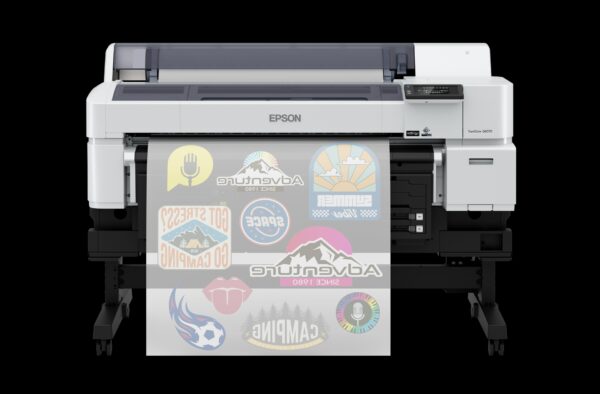Marketing Vice President Fernando Stinchi validates the OEM as a serious textile printing player.
Epson’s booth was spacious and easy to navigate.
Our first ITMA show was a huge eye-opener for us and a tremendous learning experience. We believe textile printing is another opportunity for our dealer audience and that was our motivation to attend this important global textile printing showcase. One of our biggest takeaways was how much of a player Epson is in textile printing.
Thanks to Mark Mathews, vice president, North America commercial sales & marketing, who arranged for us to interview Epson’s Fernando Stinchi, vice president, industrial products and Latin America product management. Stinchi oversees the strategic direction for all product management in Latin America, as well as label product management in the Americas, and sales and marketing for direct-to-fabric products in the Americas.
The key driver in this segment of industrial printing is that only 5% of the market share currently belongs to digital. It is still very much an analog world. Where have we seen this before?
Stinchi began the conversation by saying Epson has a highly ambitious, grand vision for growth. The company wants to grow the business 70% by 2025. This vision was initially unveiled before 2015.
The Epson Group & Monna Lisa
In 2003, For.Tex, a company located in Como, Italy, the heart of the Italian and European textile industry, became part of the Epson Group. For.Tex provides dyes, thickeners, adhesives, finishers, and other products for printing. The acquisition gave Epson a company that specializes in sales of textile printing inks. It also manufactures and sells essential treatment agents used in the textile printing processes. Epson completed the buyout on June 1, 2015. It was a well-designed move that strengthened the company’s position in textile printing.
On June 23, 2016, Epson agreed with the Robustelli family to acquire 100% of the capital of Fratelli Robustelli S.r.l. This second acquisition added a leader in the textile printing industry to the Epson Group. In hindsight, the Robustelli acquisition allowed Epson’s manufacturing capability to bring the advantages of its digital inkjet printers to more customers around the world.
F.lli Robustelli, Epson, and For.Tex jointly developed the Monna Lisa Evo Tre digital textile printer. The Monna Lisa Evo Tre series features Epson PrecisionCore Technology, offering what Epson describes as a complete solution for all textile market needs, from large scale, high-speed production to small-run, on-demand sample printing.”¯At ITMA 2019, Epson displayed the new Monna Lisa Evo Tre 64 and Monna Lisa Evo Tre 8, as well as its Monna Lisa Evo Tre 32 and Monna Lisa Evo Tre 16.
A Growing Market
In 2016, the digital textile printing market worldwide was expected to grow at an annual rate of approximately 25%, according to WTiN (World Textile Information Network) Intelligence. This statistic was offered at the time of acquisition and represents the annual growth rate through 2019.
Driving the textile printing business is the fashion industry. In years past, season changes were made over several months. Today, the fashion industry is creating new designs every month in small quantities. While one month’s shipment is on the water the next design is being created at the factory.
Stinchi described the changes digital printing has brought to the market, including greater efficiency and speed (faster than analog devices) when printing at lower volumes. This is all supported by a distribution network that provides hardware, ink, and service.
Applications and Marketing
Dye sublimation and direct-to-garment are the most prominent means of textile printing. Epson is well entrenched in the dye-sublimation market and “is going global,” according to Stinchi, who added Epson will roll out 17 direct-to-garment products in 2020.
Epson is banking on its own inkjet technology and its PrecisionCore printheads. The company has been well established in the dye-sublimation market for many years and produces lower-cost printers to address this market that can be readily sold by independent dealers. In fact, Epson prefers to use channels for its dye sublimation products. In direct-to-fabric, Epson markets directly to the customer. Direct-to-garment products are sold through channels.
Growing Textile Printing’s Digital Footprint
Our excitement about textile printing is not just our belief in its future but understanding what it will mean for those who are looking to sell in a segment of the print world that is extremely profitable and where only 5% of the print devices are digital. For dealers, this means there’s a whole new world to conquer.
The Cannata Report is making a full-court press and attending PRINTING United in Dallas in October. We fully expect to get a good look at what is being offered in the way of dye-sublimation products at this show.
With CJ, Scott, and yours truly in attendance, we intend to cover it all. We thank Fernando Stinchi for helping us further our education about textile printing.
Epson showcases the Monna Lisa Evo Tre printer.
_______________
ITMA 2019 | TEXTILE TRIPLE PLAY (Part 1 of 3): EFI
Chief Revenue Officer Frank Mallozzi puts textile printing into perspective at ITMA 2019.
ITMA 2019 | TEXTILE TRIPLE PLAY (Part 3 of 3): HP
Large-Format Production General Manager Joan Perez Pericot outlines HP’s initiatives in textile printing.
Access Related Content
Visit the www.thecannatareport.com. To become a subscriber, visit www.thecannatareport.com/register or contact cjcannata@cannatareport.com directly. Bulk subscription rates are also available.






